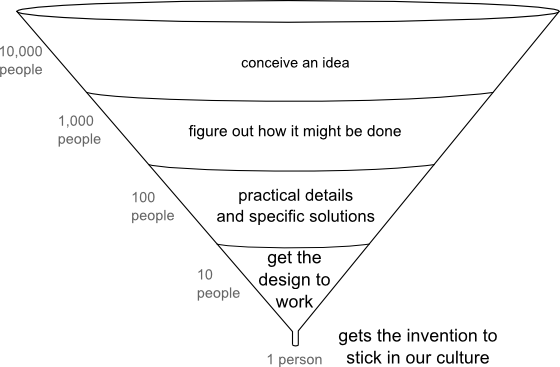The simultaneity funnel
Is your brilliant idea really that valuable?
At Agile*, we don't really place a lot of emphasis on ideas. Ideas are abundant, ideas are cheap. Ideas mean nothing without actions. And it's impossible to act on every one. Funny though, I seem to get enthralled whenever I come up with a new idea. It's conflicting because, it seems to me at least, a person with ideas is more valuable, and more interesting, than one without. Perhaps it takes a person who is rich with ideas to be able to execute. Execution and delivery is rare, and valuable.
Kevin Kelly describes the evolution of technology as a progression of the inevitable, quoting examples such as the lightbulb, and calculus. Throughout history parallel invention is the norm.
We can say, the likelihood that the lightbulb will stick is 100 percent. The likelihood Edison's was the adopted bulb is, well, one in 10,000. Furthermore, each stage of the incarnation can recruit new people. Those toiling at the later stages may not have been among the early pioneers. Given the magnitude of the deduction, it is improbable that the first person to make an invention stick was also the first person to think of the idea.
Danny Hillis, founder of Applied Minds describes this as an inverted pyramid of invention. It tells us that your brilliant idea will have coparents. Even though the final design of the first marketable lightbulb could not have been anticipated by anyone, the concept itself was inevitable. All ideas start out abstract and become more specific toward their eventual execution.

Does this mean that it takes 10,000 independant tinkerers to bring about an innovation? We aren't all working on the same problems at the same time, and some ideas arrive too early. One example is how microseismic monitoring of reservoir stimulation has exploded recently with the commercialization of shale gas projects in North America. The technology came from earthquake detection methods and that has been around for decades. Only recently has this idea been utilized in the petroleum industry, due to an alignment of compelling market forces.
So is innovation merely a numbers game? Is 10,000 a critical mass that must be exceeded to bring about a single change? If so, the image of the lonely hero-inventor-genius, then, is misguided. And if it is a numbers game, then subsurface oil and gas technology could be seriously challenged. The SPE has nearly 100,000 members world wide, compared to our beloved SEG, which has a mere 6,000 33,000. Membership to a club or professional society does not equate to contribution, but if this figure is correct, I doubt our industry has the sustained man power to feed this funnel.
This system has been observed since the start of recorded science. The pace of invention is accelerating with population and knowledge growth. Additionally, even though the pace of technology is accelerating, so is specialization and diversification, which means we have fewer people working on more problems. Is knowledge sharing and crowd wisdom a natural supplement to this historical phenomenon? Are we augmenting this funnel or connecting disparate funnels when we embrace openess?
A crowded funnel might be compulsory for advacement and progression even if it is causes cutthroat competitiveness, hoarding, or dropping out altogether. But if these options become no longer palatable for the future of our industry, we will have to modify our approach.